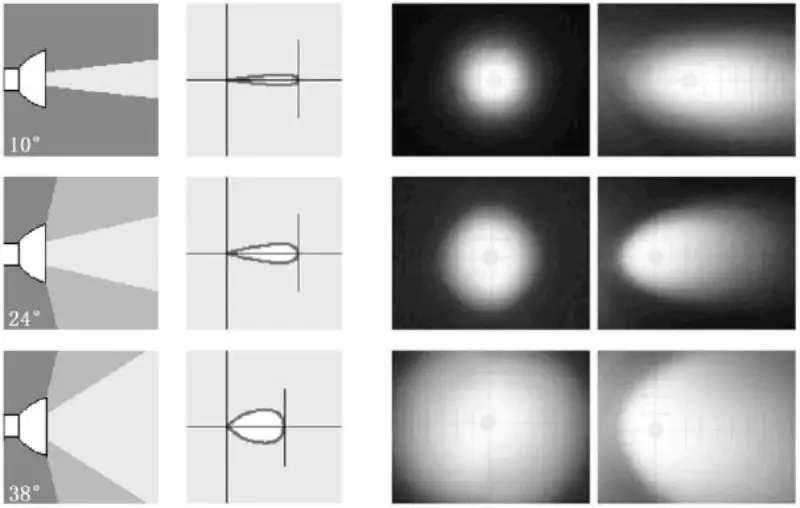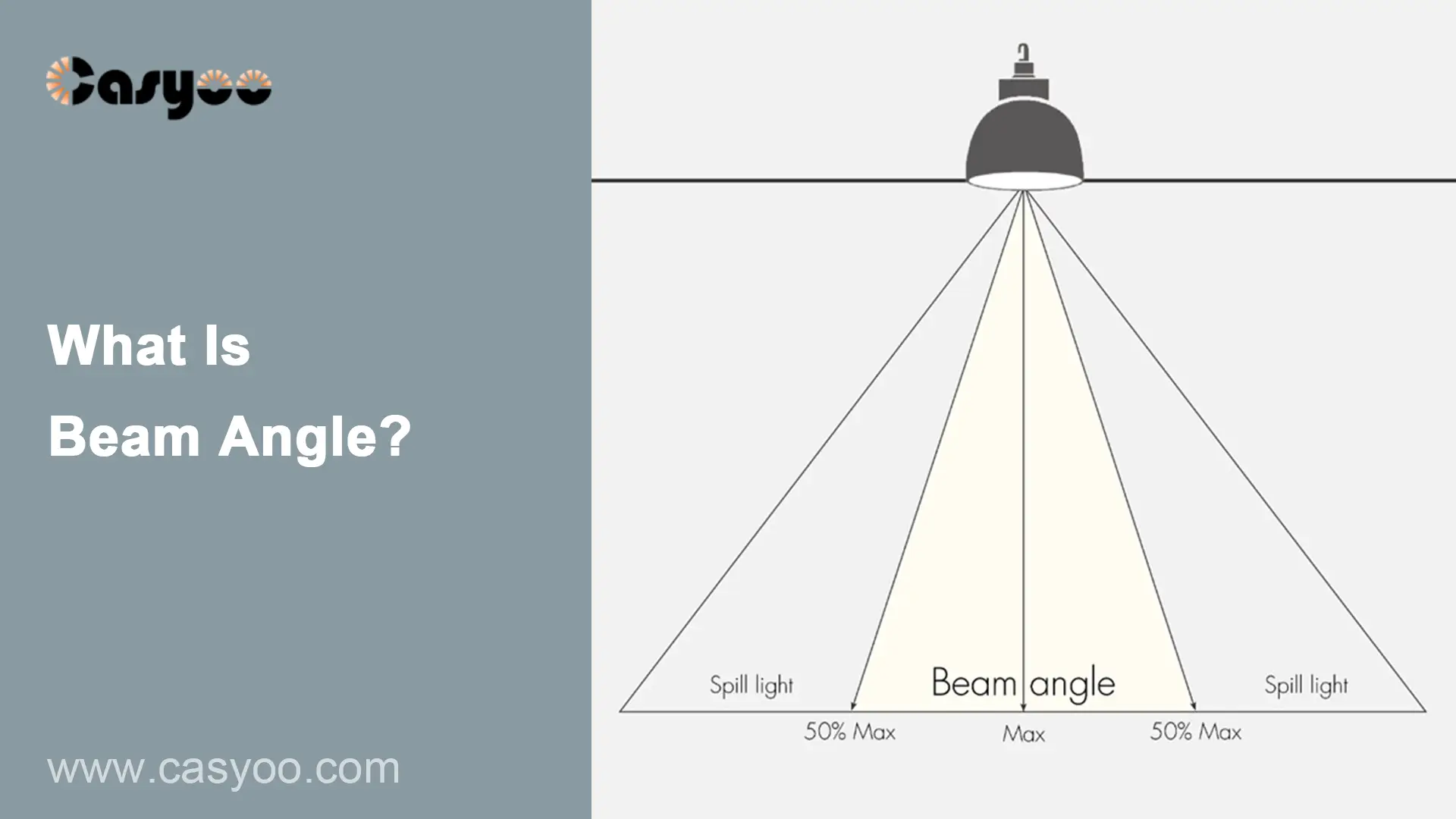According to the IES definition, beam angle refers to the angle formed by the two sides when the light intensity reaches 50% of the strongest intensity (the lamp emits the strongest light at the axis right below it). Although we cannot accurately distinguish the position of 50% light intensity, when the lamp emits light, we can see that it forms two obvious lines. The angle between these two lines is the beam angle. The beam angle of LED lights typically ranges from 30 to 120 degrees.
What are different types of the beam angle?
One of the most often used standards is the NEMA (National Electrical Manufacturers Association) beam angle categorization.
- Type 1 (10–18 degrees): Ideal for lighting sculptures or signage, or other applications requiring a narrow focus of light. At a lower luminaire installation height, it can achieve a bright and focused illumination effect.
- Type 2 (18–29 degrees): Perfect for tasks requiring focused light in a condensed space, such as architectural elements. One can generate focused lighting effects at lower installation heights.
- Type 3 (29–46 degrees): Ideal for roadway lighting and other medium-sized area illumination. In an installation position at a medium height, it is feasible to produce more even and wider lighting. If the beam angle of the roadway street lights is carefully designed, these lights can illuminate the roads precisely without wasting any energy.
- Type 4 (46–70 degrees): Fits well in places like squares and parking lots where a wide area needs to be evenly lit. A wider beam can be offered at a moderate installation height.
- Type 5 (70-100 degrees): Suitable for parking lots and squares, or other areas where a large area needs to be lit uniformly. At higher installation heights, it can achieve a variety of lighting effects.
- Type 6 (100-130 degrees): Ideal for a broad variety of lighting applications, including outdoor event spaces and sports arenas. It is possible to provide flood lighting which covers big regions at higher installation heights.
- Type 7 (130-180 degrees): Suitable for big public squares or industrial areas that require very broad lighting. A huge area can be covered at a very high installation height.

Influence of different beam angles
A change in beam angle may have an impact on the following aspects:
- Irradiation range: A narrower beam angle results in a smaller light irradiation range and a more concentrated irradiation spot. The irradiation range and light spot dispersion increase with increasing angle.
- Illumination: For a given light source, the brightness of light at the illumination center increases with decreasing beam angle. The reason is that compared to a source with a wider angle, the light is more focused.
- Glare: Both big and small beam angles can reduce glare, but in different ways. Because of the small beam angle, light spillage and glare are avoided. A wide beam angle helps reduce glare from too much light coming from underneath the lamp and improve uniformity of light.
- Decorative effect: While lighting fixtures with large beam angles can offer broader background illumination, those with small beam angles can highlight a particular object.
- Position and height of installation: The smaller the angle, the higher the lamp’s installation height to cover a specific illumination area, and vice versa.
Why is the beam angle important?
Different beam angles are needed for different application circumstances. For instance, a smaller beam angle (like 15°–30°) is ideal for spotlighting or accent lighting, whereas a greater angle (like 60°–120°) is ideal for general lighting or creating a wall washing effect.
If a given application needs direct light sources, utilizing a small beam angle can minimize the amount of light wasted, increasing energy efficiency.
Selecting the appropriate beam angle for outdoor lighting can highlight or conceal architectural features. For instance, a narrow beam of light can highlight the three-dimensionality of architectural columns, while a broad beam can even out wall defects.
How do you choose beam angle?
- Understand beam angle in the light distribution chart:
In the specification file the manufacturer provide, there will be a light distribution chart. Now as you know the meaning of beam angle, you can imagine the illumination range of the lamp by reading the chart.

- Best beam angle recommendation for different settings:
Spot lighting(10°-25°): Accent lighting for artworks, shop windows, courtyard landscapes, and building exteriors
General lighting(25°-45°): Local lighting of dining tables, desks, kitchen, and building entrances; regional lighting of living rooms, conference rooms, corridors, parking lots, and gardens.
Flood lighting(45°-120°): Large indoor spaces like restaurants, malls, offices, school, or stadiums; street lighting; Large outdoor areas like squares and parks
Wide range lighting(120°-180°): Wall wash lighting; Uniform lighting for shop windows and billboards; Pathway lighting
- Lighting distance: A smaller angle can maintain lighting intensity at a long lighting distance. For close-range lighting, a wide one can prevent creating an overly concentrated spot.
- Considering the lit target: When illuminating smaller targets or details you wish to draw attention to, you should take into account narrow beam angles. When covering wider areas or illuminating widely dispersed objects, a broad one is preferable.
- Energy efficiency and consumption: Lamps with different beam angles may have varying energy efficiency. To keep the same level of illumination, narrow-beam lights needs more power.
- Safety laws and standards: In certain settings, such as public spaces and workplaces, there might be safety standards or restrictions about the beam angle and intensity of lighting. Anti-glare requirements and the avoidance of high-intensity direct light sources may further influence what you should select.
Conclusions
In this passage, we have discussed the definition, influence, categories, importance of the beam angle, and how to choose the right one. I hope it can be a guide when you are choosing LED lights. You can also contact us and get recommendations on LED lights with the specifications you need.




